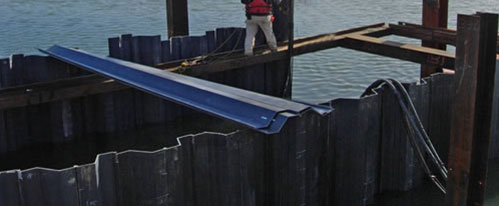What is Sheet Piling Used For?
The pressures of large-scale construction are enormous. Engineers and site managers must adopt multi-faceted roles to ensure that architectural projects do not collapse due to supply-chain issues or weather-related problems. They also need to shore up the ground itself to ensure it doesn’t literally sink at any point in its lifetime. Sheet piling is the go-to solution for construction companies – for the latter issue, at least.
Basic Benefits of Sheet Piling
Any structure in the proximity of moist land or water runs the risk of flooding. All engineers and structural specialists understand the importance of building on a strong foundation, and of mitigating as many future risks as possible. Sheet piling offers a measure of safety and support that makes both parameters possible. It is commonly deployed early in the construction process to safeguard building sites and budding structures from damp ground or an uneven or unsteady base.

Sheet piling has a long list of ticks in the plus column. These include:
- High load-bearing capabilities, enabling it to withstand colossal weights.
- Impenetrability to corrosive/hazardous materials, which could cause catastrophic damage to building foundations.
Major Industrial and Commercial Applications of Sheet Piling
Stongwell’s sheet piling solutions have been regularly utilized over the past decade in a variety of commercial, private, and public sector projects; the US Army and Navy, US Fish and Wildlife Association, and a multitude of other municipalities.
Used to prop up retaining walls and underground structures such as car parks and basements, sheet piling serves as a long-lasting line of defense against external erosion. Constructions in coastal areas such as seawalls and dams are most at risk.
The Shortcomings of Steel Sheet Piling
Traditionally, sheet piling production has been predominantly carried out with steel. The sturdy and dependable selection of other construction companies for years, steel does a solid job but falls short when measured against its modern alternatives.
Despite undeniable strength and durability, the upfront material costs are comparatively high, as are labor and installation. Once finally fitted, steel sheet piling tends to suffer from corrosion and oxidation issues. Though still a staple engineering material in many respects, steel is increasingly coming up against prohibitive limitations in many areas of commercial and corporate construction.
Innovations and Improvements in Sheet Piling Technology
At Strongwell, our latest fiber-reinforced polymers (FRP) products, including fiberglass fixtures, are convincing our cost-conscious customers to calculate the pros and cons.
Want to learn more? Read our article Outlining Fiberglass Sheet Piling
Keeping in mind that sheet piling’s primary purpose is to protect a manmade structure against the natural fibers it is nestled upon or amongst, no other material is more suited to the task than one with an FRP base. Its waterproof properties and high-strength composition make it ideal for sheet piling applications.
What better composite collaboration of corrosion-resistant matter is there than fiber-reinforced polymers? Contact us today if you would like to learn more.